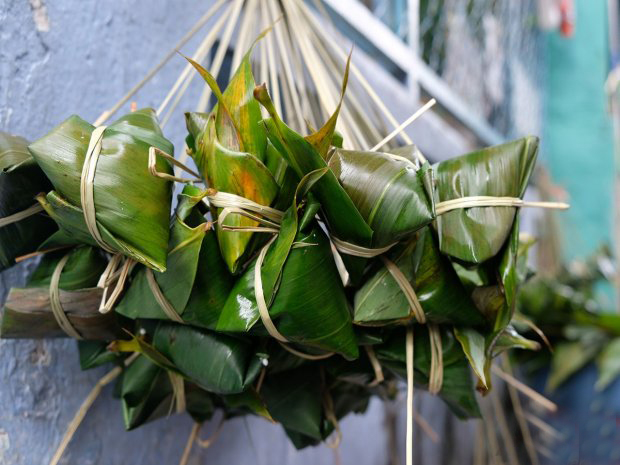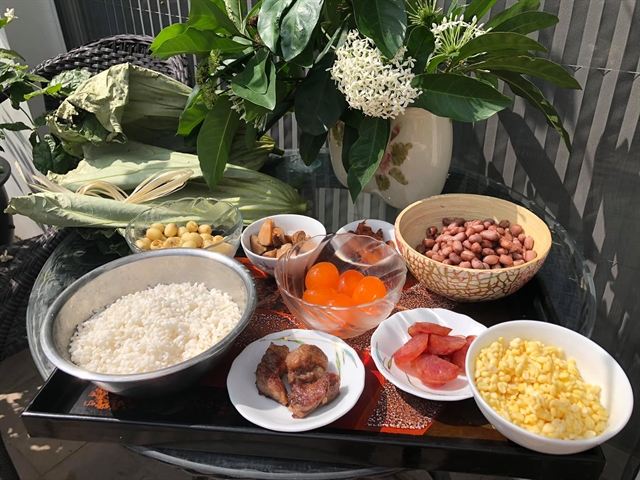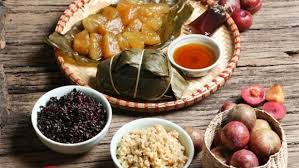 Life & Style
Life & Style


|
| Cantonese bak chang must be wrapped in bamboo leaves. Photo courtesy of SaoStar.vn |
Nguyễn Mỹ Hà
It's the fifth day of the fifth lunar month this week and Vietnamese families are preparing homemade goodies to detox in the traditional way.
Đoan Ngọ Tết, or getting rid of germs from inside your digestive system, is a custom at this time of year. This Thursday is the big day and the temperature has been forecast to soar close to 40 degrees Celcius, so the traditional meal of fermented sticky rice may be tough to scarf down.
Good thing that tradition has it that the rice is followed by fruit such as plums, litchis, or pineapples, all considered hot fruit to clear germs from your system.
Also celebrating at this time of year is the Chinese community in Việt Nam. Nearly half a million people of Chinese descent call District 5 in HCM City home. Chinese people living in Việt Nam tend to be descendants of people from Guangdong, Chaozhou, Fujian and Hainan provinces. They speak Cantonese and maintain strong cultural and culinary traditions.
For Đoan Ngọ Tết, Chinese residents in HCM City make traditional bá trạng dumplings, known also as the Cantonese bak chang meat dumplings.

|
| It takes a long time to get all the ingredients ready to make the dumplings. VNS Photo Mỹ Hà |
While in Red River Delta provinces, Vietnamese mothers make the sticky rice ash dumplings for the occasion, which have no meat and are served cold with sugarcane molasses.
Some people may find that the bak chang dumplings are quite similar to Vietnamese Lunar New Year square cakes. Both use leaves to wrap sticky rice with meat and nut stuffing inside. They are only different in shapes and flavours. While the square bánh chưng has three main ingredients, bak chang have more than that.
Bak chang dumplings need to be boiled in water for two and a half hours, whereas bánh chưng need to be boiled between 10 and 12 hours to make the ingredients completely melt, then they are pressed with stone to remove all the water that soaked into them.
In Việt Nam, bak chang dumplings are more popular in the south, where the Chinese community is much bigger. Many Hanoians say they have never heard of this kind of dumpling.
Traditional Cantonese bak chang features glutinous rice stir-fried with dark soya sauce, five-spice powder pork, marinated egg yolk and thick shiitake mushrooms. The flavour is typical Cantonese with soya sauce and dark sauce sauteed in the rice, meat and mushrooms. While sticky rice is a must, stuffing variations include chestnut and pork, chestnut, pork and mushrooms and salted egg yolks.
The Canton region is also home to sea-faring traditions and they also add seafood to the dumplings. The ingredients can include dried shrimps, scallops and oysters, stir-fried in oyster sauce.
The true Cantonese bak chang dumplings must be wrapped in big dried bamboo leaves, which are not harvested for food in the north of Việt Nam. The dried leaves must be boiled, washed and dried with a towel before wrapping.
In HCM City, you will also find bak chang sold in banana leaves. Some say that it's the Chinese tradition married into the Vietnamese family. The ingredients can be the same, but when the leaves are not the same, the wrapping and size of dumplings vary as well.
With bamboo leaves, you can make triangle dumplings, that look just like their ash dumpling sisters, whereas banana bak chang dumplings are wrapped into square buns.
Houses selling bak chang dumplings in HMC City also have their own version of stuffing. Some add mung beans, lotus seeds and peanuts. Some add lạp xường (pork sausages Chinese style), and last but not least, the salted egg yolks as the centrepiece of the dumplings. The yolks combine and enhance all the flavours to the next level.
At Chinese dim sum restaurants, you can also have a shortened version of bak chang with sauteed chicken and fragrant mushrooms.

|
| Traditional Tet Đoan Ngọ food in the north comprises of the ash dumplings with sugarcane molasses, fermented black and white rice and assorted fruit. Photo courtesy of Thể thao Văn hóa magazine |
This year, the Đoan Ngọ Tết has been delayed further, which coincides with the lotus blooming season in the north of Việt Nam. If you travel further from the cities, you'll find swamps with the lotus in full bloom and ripening rice fields mixed with lotus ponds.
In Hà Nội's West Lake, the few hundred-petal lotuses are in bloom, and ladies wake up early in the morning to get the first sunlight to pose for photos by the lotus pond.
The atmosphere in the early morning on a lotus pond is refreshing, beautiful and fragrant. After taking a walk and finding a quiet corner to sip lotus tea on a morning like that, I was inspired to try to wrap my version of the bak chang with lotus leaves. Hanoian sticky rice sellers also use fresh lotus leaves to wrap sticky rice to sell at about 6.30am for the early birds for work or school.
I also made a change in the stuffing, replacing chestnuts with lotus seeds. So my dumplings cannot be called bak chang dumplings anymore. I call them lotus dumplings, steamed instead of boiled in water. This time of year always reminds me of my Grandma, so I offered them to her on the altar, and I believe somewhere up there between the white clouds, she is looking down on me with a smile! — VNS




